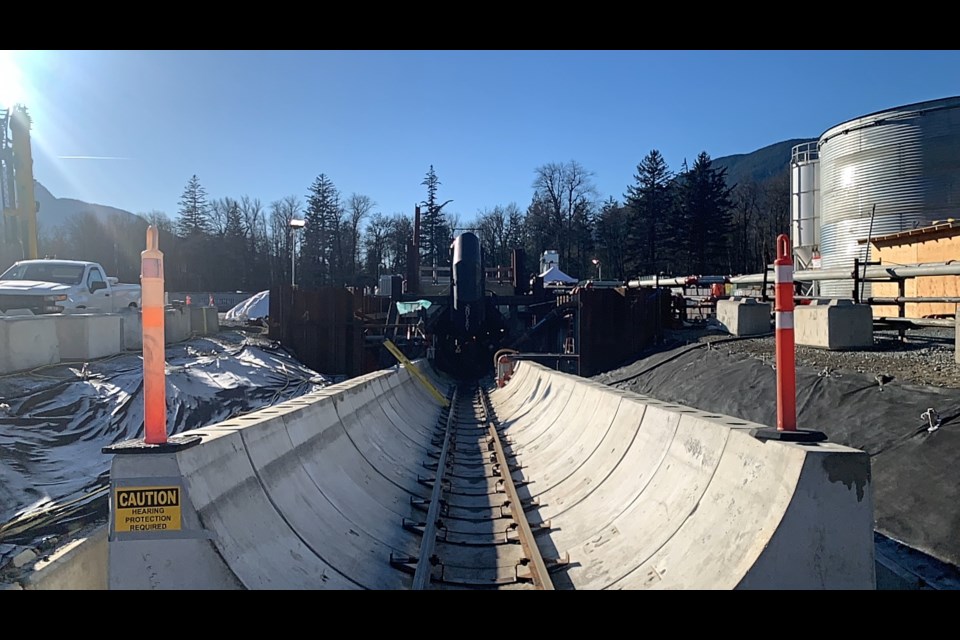The Woodfibre LNG project and its associated Eagle Mountain-Woodfibre Gas Pipeline Project have been on the radar of locals for about a decade, and construction has been underway in earnest since 2023.
Perhaps one of the aspects of the project that is of the most interest to locals is the tunnel for the natural gas pipeline, which will stretch under the Skwelwil'em Squamish Estuary.
As a refresher, Woodfibre LNG is currently building a liquefied natural gas (LNG) export facility about seven kilometres west-southwest of downtown Squamish on the shore of Howe Sound.
The facility is slated to operate for approximately 40 years. The project will include a natural gas liquefaction facility and an LNG transfer facility.
The facility will have a storage capacity of 250,000 cubic metres and a production capacity of 2.1 million tonnes per year of LNG.
FortisBC has been tasked with supplying natural gas to the $5.1 billion project.
The utility company is installing about 50 km of new natural gas pipeline between Squamish and Coquitlam.
Nine kilometres of new pipeline will be underground within the tunnel that will stretch under the estuary.
The entrances to the tunnel are at the former BC Rail yard site off Government Road and at the Woodfibre LNG site.
The Squamish Chief took a guided tour of the rail yard site on Jan. 29.
By the numbers
Frontier-Kemper/Michels Joint Venture has the contract for the tunnel portion of the pipeline project.
In 2022, the contractor’s parent company, Tutor Perini Corporation, said in a news release the contract was worth approximately $341 million.
In 2016, FortisBC told the provincial government that the total Eagle Mountain Project’s capital expenditures would be approximately $520 million.
(Asked for an updated figure, a spokesperson for FortisBC said the project’s costs are subject to a confidential private agreement with Woodfibre LNG, which prevents them from disclosing the details.)
The tunnel portion of the project includes two tunnel-boring machines—known as TBMs.
The BC Rail yard side of the project is known as the soft-ground side of the tunnel, while the Woodfibre side is known as the hard rock side.
The soft ground tunnel width is four metres, while the hard rock width is 4.5 metres, according to FortisBC.
The underground tunnel will reach depths between 25 and 430 metres below ground.
According to Frontier-Kemper/Michels JV, the creation of the tunnel will include:
- 5.02 km (3.12 miles) of hard rock tunnel boring;
- 3.8 km (2.36 miles) of soft ground tunnel boring.
So far, the tunnel for the hard rock side has advanced over 700 metres, and the soft ground side has advanced over 200 m, according to FortisBC.
According to the tour spokesperson for the Eagle Mountain – Woodfibre Gas Pipeline Project, Darrin Marshall, the project's director, there can be up to a rough total of 200 workers on the tunnel portion of the project, though that figure is on the high end and unlikely all would be on-site on a given day.
The work continues around the clock, seven days a week, barring maintenance requirements and tunnel conditions.
The setup at the Woodfibre LNG site is narrower, but similar to what is at the rail yards.
The tour
After checking in with security and having a safety orientation for the tour, one thing that stands out about the work site at the rail yards is that the work is segmented.
Think of a series of those green Lego baseplates with different components of a larger "city" or worksite in each section.
Some sections, for example, deal with removing sediment from the water that is needed in the tunnelling process, for such things as cooling the machinery and mixing the slurry needed for tunnelling operations.
FortisBC says that most of the water is recycled back and reused on the soft ground BC Rail site.
In another section of the yard are concrete pieces that look like thick grey versions of Pringles chips stacked up in neat piles.
These are the segments that, put together, will line 3.8 kilometres of the soft ground portion of the tunnel. They are custom-made in Nanaimo.
The opening to the tunnel itself is underwhelming, as the impressive bits are underground. To the naked eye, it is simply a hole with a narrow track running into it.
Inside the tunnel, workers have a washroom and a small lunchroom.
Small trolleys take the workers and supplies in along the track.
Two gas pipelines will be installed within the tunnel.
The one pipeline will feed the gas to Woodfibre LNG, and the second is for redundancy. Once the tunnel is complete, it is not built to be accessed regularly, so duplication of the pipeline increases the reliability and fault tolerance of the system, according to Marshall.
Pipes
There is approximately 61 kilometres of pipe in the pipe yard.
The pipes came from Germany by way of the Panama Canal, arriving finally at the Squamish terminals.
The pipes have varying thicknesses, depending on the location they will be placed.
"I learned a lot in global logistics through that process," Marshall said.
The pipelines will be installed one at a time.
The pipeline has at least a 50-year lifespan, Marshall said
Challenges
The project has not been without its challenges, which have played out publicly given the Environment Assessment Office publishes any infractions found by regulators, and these are picked up by the media, including The Squamish Chief.
Asked if there was anything he wished the public understood about the project that perhaps they don't, Marshall said it is tough to condense down to a soundbite all that has been done to date.
"What's been a challenge for me over the past seven years is conveying to the public the extensive planning and mitigation measures that we've implemented, and we continue to implement to reduce our impact on the environment," he said.
"It's a very challenging thing to take thousands of pages of environmental mitigation and distill it down into key messages. We've implemented these measures. We have had instances where they didn't work as intended. And obviously, those are going to be public, but our overarching philosophy is adaptive management. So, where we see these mitigation measures not working as intended, we implement corrective actions and make sure that we have appropriate mitigation moving forward to prevent recurrence. And that's, I would say, the single biggest challenge for me; how do you convey that to the average public ...there's no TikTok video going around about that,” he added, noting that the plans took years and that FortisBC works closely with Sḵwx̱wú7mesh Úxwumixw (Squamish Nation), the Tsleil-Waututh Nation, the District of Squamish, among others.
"Have we been perfect? No, but no one expects perfection, which is why these processes contemplate adjustments. They contemplate things like self-disclosures and all these different things. And so I think … that what we've experienced to date is no different than any other major project.”
The tunnel is set to be in service at the end of 2026.
Woodfibre LNG is slated to be in operation in 2027.




